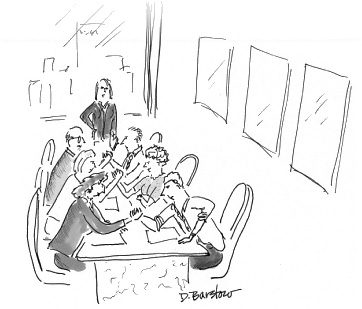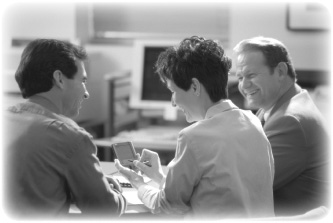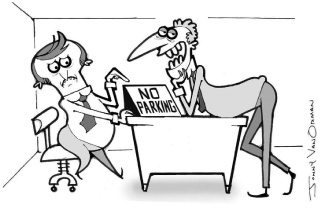CHAPTER 7
You’re in My Space
HAVE YOU EVER FELT ANNOYED when you re-entered a meeting and found “your” seat taken by someone else? Have you felt offended when a co-worker entered your office without knocking or when you discovered your boss shuffling through papers on your desk?
Sure you have!
We all try to protect and control our space. It’s called territorial behavior, and it is hardwired in our brains. In fact, territoriality is established so rapidly that even the second session in a series of lectures is sufficient to find most of the audience returning to their same seats.
In this chapter you’ll see how the use of space in the workplace sends its own set of messages. You’ll understand the impact of spatial zones—those distances between people that are most appropriate for various interactions—and why some people choose to disregard them. You’ll see why seating arrangements are so important in business meetings and what someone’s office can tell you about the person occupying it.
“I feel close to her.”
“He is very standoffish.”
“Back off!”
“She keeps me at arm’s length.”
Like facial expressions, hand gestures, and body postures, space speaks. And proxemics—the study of space as used in nonverbal communication—says volumes about relationships. People communicate through the distances they maintain during encounters.
TRY THIS At your next business meeting, notice who sits next to whom. Most of the time, people choose to sit near others they like and agree with about the topic to be discussed. They will also find ways to put distance between themselves and those they dislike. |
Spatial Zones
A salesman was taking a client out to lunch, and by the time they’d finished their drinks at the bar, I knew the deal was lost. I watched the salesman move so close to his prospect that the client began, very slowly, to inch away. When the client could stand it no longer, he excused himself to make a phone call—and left the restaurant shortly thereafter.
One of the easiest mistakes to make during an encounter with someone is to misjudge how much space the other person needs to feel comfortable. A mistake here can trigger a truly deep-seated response. Anthropologist Edward T. Hall was one of the pioneers in the study of proxemics (in fact, he coined the word), and he found that people’s territorial responses are deeply rooted and primitive. They are also predictable—if you know what to look for.
There are five zones in which people feel most comfortable in dealing with one another. One way to think of these is as a set of invisible bubbles we all carry with us into the workplace.
Intimate zone (0 to 18 inches) This zone is reserved for family and loved ones. Within this zone we embrace, touch, and whisper. This close contact is appropriate only for very personal relationships.

Close personal zone (1½ to 2 feet) This is the bubble most people in the United States like to keep around us. This zone is used for interactions among friends or familiar and trusted business partners.

Far personal zone (2 to 4 feet) This zone is for interactions we prefer to conduct at arm’s length. In this zone we can communicate interest without the commitment of touching.

Social zone (4 to 12 feet) The social zone is most appropriate for the majority of daily business interactions. It is where we interact with new business acquaintances or at more formal social affairs.

Public zone (more than 12 feet) This zone is mostly used for public speaking.
All these zones are, of course, invisible to us and to others, but that doesn’t make them any less real. Few of us are comfortable in a crowded subway train or elevator, where we are forced into an intimate distance with people we don’t know. In those cases, we usually look straight ahead and avoid making eye contact. And as strangers edge into our personal space, we will often lean or move away from them in an attempt to create an acceptable distance.
The amount of space required to feel comfortable varies from individual to individual. People who don’t like being touched tend to keep their distance from others. People who touch others while talking want to get close enough to do so.
And, of course, space can also vary depending on the amount of trust in a relationship. The greater the distance, the lower the level of trust.
We also make assumptions about relationships based on zones. If we see two people talking at a distance of about two feet from each other, we assume they are engaged in the kind of conversation possible only between those who know each other well. So, their spatial relationship becomes part of what is being communicated.
Gender also plays an important role. Men who don’t know each other well tend to keep a greater distance between them than women who have just met. This difference in interpersonal distance as determined by gender is even true in Web 2.0’s virtual online worlds (such as Second Life and social networking sites), where many of the rules that govern personal space in the physical world can be found in the virtual world.
TRY THIS Whether you work in an office building, a factory, or a department store, you have many opportunities to observe people in workplace conversations. As you do, notice the distance that separates them. See if you can guess the trust level between co-workers by the spatial zones they occupy when interacting. |
It’s also interesting to note that we all allow some people to get closer to us than others. Research from the University of Arizona finds that those who have positive qualities (attractive, well dressed, higher status) are more easily able to invade other people’s space. And, of course, some professionals—beauticians, personal trainers, doctors, and massage therapists—routinely encroach on our personal space. As a dental hygienist noted, “The practice of dentistry throws the notion of proxemics out the window. The idea of one’s ‘intimate zone’ is completely ignored and abused, as we all know when someone is poking and scraping in our mouths. In those special circumstances, there is an unstated agreement between patient and dental practitioner that the laws of proxemics will be suspended. But as soon as treatment is completed and the patient is upright again, the rules resume immediately.”
Business Zone
Most U.S. business relationships begin in the social zone. As the relationships develop and trust is formed, both parties may subconsciously decrease the distance to the personal zone. But if one of the parties moves too close too soon, it can result in a communication breakdown.
When people are not aware of these zones and the meanings attached to them, unintentional violations may occur, resulting in discomfort and distrust. Those who feel powerful often display their confidence by taking up a large amount of physical space. In so doing they may unknowingly infringe on another person’s territory.
Of course, violating someone’s personal space can also be deliberate—to create discomfort. Police interrogators often use the strategy of sitting closely and crowding a suspect. This theory of interrogation assumes that invasion of the suspect’s personal space, with no chance for defense, will give the officer a psychological advantage.
Too close for comfort
In the one-upmanship that is all too often part of organizational life, I’ve watched high-ranking executives purposefully stand too close, to make a competitor feel self-conscious or uncomfortable. I’ve seen managers crowd staff members to emphasize their status in the organization.
But regardless of their motive, anyone who comes too close to you in an undesirable way triggers a physiological reaction: your heart rate and galvanic skin responses increase. You then try to restore the proper distance by withdrawing and retreating. You may look away, pull back to create space, step behind a barrier (desk, chair, or table), tuck in your chin toward your chest in an instinctive move of protection, or even rub your neck so that your elbow protrudes sharply toward the invader. This shows that proximity is a powerful nonverbal force and that most people need to increase their sensitivity in using it.
Again, regardless of motive, people who overstep our space boundaries are perceived as either overly aggressive or socially clueless. Getting too close is an especially improper business move in circumstances where co-workers, colleagues, or clients are in danger of feeling emotionally or physically threatened by the invasion of their personal space.
Notice how you react when someone gets too close to you—and try to guess his motive for invading your space. (Is he attempting to intimidate you? To impress you with his status? Or is he simply unaware?) |
Space and Status
Space in the workplace often indicates dominance and leadership. The higher the professional status an employee has, the more space he or she is commonly awarded. Another difference can be seen in how close one approaches the desk or chair of another. People who enter a room but remain near the door signal lower status than those who walk all the way in. In fact, whether we know it or not, we generally judge people to have low confidence or little power when they keep an increased distance from us, while we associate high confidence and more power with a willingness to get physically closer.
As mentioned, another way that status is demonstrated nonverbally in a meeting is by physically taking up space (claiming your territory). Lower-status, less-confident men (and most women) tend to pull in. They keep all their materials in one neat pile, whereas more-confident or higher-status men will usually spread out their papers and claim their turf.
In meetings the person with high status is usually seated at the end of a table (the power position). When a new person enters the room, he will often adjust his jacket, touch his hair, or make other adjustments to how he looks. This lets the person in power know subconsciously that the person entering cares about how he presents himself. Senior staff members often sit to the right of their boss at the head of the table—perhaps the origin of the term right-hand man.

“We’re reorganizing our infrastructure. Everyone move two chairs to the left.”
In any meeting you might be hosting, keep the desired goal in mind and choose the setting carefully. A boardroom will probably have a large rectangular or oval table, creating space for higher-status people to sit at the head, and thereby control the agenda, and giving the meeting a formal and businesslike feeling. But for a meeting in which you want collaboration and participation, you probably wouldn’t want such a pronounced hierarchical arrangement, nor would you want the rest of the team sitting across from one another in adversarial positions. The rule of thumb here is: if you want to foster a competitive element, place opponents on opposite sides of the table; if you want to stimulate collaboration, seat people side by side. |

“Ladies! Gentlemen! Arm wrestling never solved anything!”
Take a Seat
People’s seating arrangements can shape their interactions by allowing or blocking eye contact and visibility of other non-verbal cues. Seating positions may even help create leaders. For example, people who sit at either end of the table in a jury room are more likely to be elected foreperson.
One experiment randomly assigned college males to sit in particular seats at a table. The researchers arranged it so that more people were seated at one half of the table, and only two people sat on the opposite side—and these two seats were considered “visually central” because their occupants would be highly observed from the more crowded side. As was predicted, occupants of the visually central seats received the highest ratings in leadership after discussions had taken place.
Of course, this study raises more questions than it answers: Were the two men really leaders, or was it the seating arrangement that allowed others to perceive them that way? Or did the two men begin to act differently because they felt they had the central position and it was their job to speak up? It’s hard to know exactly what happened, but it might be interesting to experiment with seating at your next meeting and draw you own conclusions.
TRY THIS If you are having dinner with a business partner, find a table that allows you to sit at right angles to each other. It may have a positive impact on the quality of your conversation. Research shows that people are more interactive when seated at right angles than when straight across from each other. |
I often speak in front of audiences in theater-style, straight-row seating. But when the meeting planner gives me a choice (and when the audience is small enough—say, less than three hundred—to accommodate it), I always request round tables of six to eight people. Here’s why: I like a lot of audience interaction. In straight-row seating, the location of participants is a major factor in determining how individuals respond and how involved they are. (Research shows that, in such an arrangement, participant interaction is greatest in the front and middle rows, regardless of whether the seating is imposed or self-selected.) With tables, I can encourage small-group discussions and then take a wireless microphone into the audience and get reactions from anywhere in the room.
TRY THIS If your objective for a meeting is to stimulate teamwork, find a round table, where everyone can sit in a circle. This arrangement sends a nonverbal signal of equality and facilitates communication among participants. The legendary King Arthur understood the power of this arrangement when he chose a round table for his knights. That way no one had higher status than anyone else. |
Objects as Barriers
Another way that people use space to send nonverbal messages is to fill it with things they can hide behind. People often use objects as barriers when they are uncomfortable with what is being said, when they feel they are being coerced, or when they otherwise feel the need for protection.
Norma, a manager I was coaching, used to hide from my critique by creating a physical barrier between the two of us. She was quite relaxed and open so long as my comments about her leadership skills were positive, but whenever I discussed an area that needed improvement, Norma would unconsciously begin to line up objects (coffee cup, books— even her purse!) on the desk in front of her.
Office Layout
I’ve often noticed that executives communicate their attitudes about power and status by the way they utilize their office space. If you walk into someone’s office and find a conversation area (chairs of equal size set around a small table or at right angles to each other), you’ll probably infer that the occupant likes to speak with guests more casually and personally than he or she could from behind a desk. That office layout tells you that the person is informal and most likely collaborative. On the other hand, the message you get from someone who conducts all interactions from behind a large desk, with his or her guests seated in smaller (and almost always more uncomfortable) chairs stationed in front of the desk, is one of control or superiority.
Of course, not everyone is an executive and not all offices or workspaces have enough room for a separate conversation area. But many offices could be made more inviting to guests by simply moving the visitor’s chair to the side rather than in front of the desk.
Savvy leaders know the power of office layout as a metaphor for workplace relationships. That’s why many successful businesspeople choose not to speak with clients, customers, or employees from behind a desk but instead come around the desk and sit next to them. A manager in a manufacturing company uses this strategy with new employees: “When I first meet with members of my staff, I pull my chair to the opposite side of the desk so that we are sitting next to one another. I tell them that sometimes I may physically be seated behind my desk, but that this is the way I think of us—as partners working side by side.”
This arrangement divides people.

This arrangement brings people together.
Contrast that with the senior project manager who conducted meetings in his office by placing a worktable perpendicular to the front of his desk. He sat in a comfortable chair behind his desk while the rest of the “team” sat in armless chairs at the table. This arrangement allowed the manager to reinforce his role as the authority figure in the room. In the words of one participant in those meetings, “There he’d be, leaning back in his big chair, while the rest of us sat upright at the table. We felt like peasants who’d been summoned by the lord of the manor!”
If you want to use your office space to enhance a conversation, don’t put any object between you and the person with whom you’re talking. Move out from behind your desk when you want a real dialogue and stay behind the desk only when maintaining control is more important than exchanging information. |
Workplace Design
The layout of your organization sends its own nonverbal messages. Here’s an example of one company that used design to encourage collaboration. At Caterpillar’s European headquarters in Geneva, Switzerland, employees represent a mixture of nationalities from all over the world. While essential for a successful global operation, this diversity complicates communication: not only are employees dealing with multiple languages and backgrounds but they’re interacting with people who come from very different cultures. The challenge was how to make this diverse population think of themselves as a team.
A few years ago, Caterpillar’s employee communication manager, Gottardo Bontagnali, kept thinking about the role played by the central market square— piazza in Italian—in virtually all European villages. In addition to going there for necessities of daily life, villagers went to exchange news, pick up gossip, pass on information, and socialize. It was, and in many places still is, the village’s most efficient communication tool.
So Bontagnali decided to create a “piazza” at Caterpillar’s Geneva headquarters, based on the village theme. Local artists were brought in to paint the walls of the top-floor cafeteria with large village scenes—dotted with bright yellow Cat machines, of course—as well as sights from multiple Cat locations. And the villagers portrayed in the panoramas were actual Cat employees. The result was amazing: with a little imagination, you could actually picture yourself in a European market square surrounded by familiar sights and faces.
Employees were then encouraged to use the piazza for informal meetings and discussions. “Let’s discuss it over a cup of coffee in the piazza” has now become part of Caterpillar’s business culture in Geneva. And because so many people use it for regular exchanges, it’s become an important means of sharing information on an impromptu basis as well. But the most impressive result is how workplace design helped build workforce camaraderie and a common sense of purpose.
In a completely different type of enterprise, AdFarm, a Canadian advertising agency, uses workplace design to symbolize organizational values. According to Art Froehlich, a senior partner with the firm: “In our organization the owners have windowless offices, and staff members are assigned the nicer rooms with views. No one has a corner office. All those are turned into meeting rooms. Using space this way is one way we communicate our values to employees. And, by the way, we’ve been chosen as one of the fifty best work-places in Canada.”
Using space, creating your own space, or invading someone else’s space can, as we’ve seen, play a critical role in how we interact in business situations.
It’s been decades since space exploration began and the first Russian and American satellites orbited the Earth. As it applies to professional relationships, however, it seems that we are on the frontier of a different “Space Age.” Make that exploration work for you by understanding the messages that are being sent—and need to be respected—when people use space and distance as part of their workplace communication.



